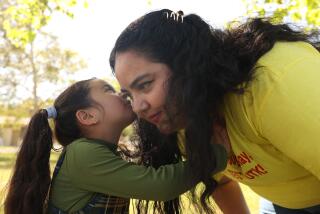Pretzels and Kids’ Fitness
- Share via
OK, lift your right arm and bend the elbow so your hand extends over the right shoulder behind your head. Now bend your left elbow behind your waist so the hand extends upward. Try to make the fingers of the two hands touch in the middle of your back.
If your fingers are still wiggling unsuccessfully toward each other, be glad the state isn’t looking. You would be counted among the physically unfit.
Every year, along with the saddening news about academic test scores, Californians are treated to a woe-fest over how few students pass the state’s physical fitness exam -- 27% by this year’s count. Then state schools Supt. Jack O’Connell delivers some generalized pronouncements on how schools “need to do more,” without offering any specific help.
It’s a curious thing. Parents spend all their free time shuttling their kids to soccer games and basketball practices, yet all these children are unfit? Hard to believe, but perhaps, in this Age of Testing, we’d rather not question the official rubric. Why deprive ourselves of our addiction to dismal news about the state’s kids?
The physical fitness exam, given to students in fifth, seventh and ninth grades, has six parts -- aerobic fitness, body composition, flexibility, and strength of the abdominal, back and upper-body muscles. Even a youngster who runs several miles a day and can do a load of one-handed push-ups will fail if he or she doesn’t make the grade on all the other parts of the test -- like making those fingers touch. True, only about 25% of the students tested last year passed all six tests. But more than half passed at least five.
Schoolchildren aren’t the total slugs we might think. A recent study by Public Agenda found that eight of 10 middle and high school students nationwide participated in some type of organized activity -- usually sports -- outside school on weekdays and weekends.
No one is saying the state should dump the test, which is fine for measuring different types of fitness and can point up areas that need work. Most worrisome: Children in urban schools, where obesity rates are higher and neighborhoods are sometimes too dangerous for a bike ride, do far worse on the tests than their suburban counterparts.
We can see when kids are getting too fat or too lazy. What we seem to have lost is the ability to believe our own eyes rather than the Official Test Score. When we observe lean, apparently healthy kids enjoying sports, dance or a long walk, maybe we can relax enough to believe they’re OK. Really. Even if they can’t touch their fingers in back.
Uh, if you’re not frozen into an upper-body pretzel, you can put your arms down now.


